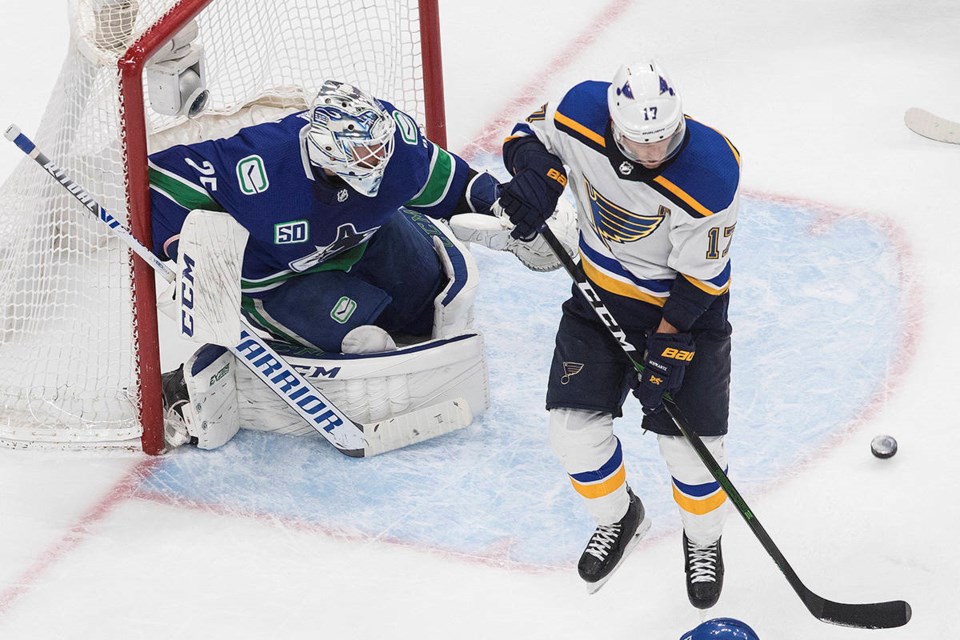These are the biggest games of Jacob Markstrom’s career, but he’s never looked more relaxed.
The broadcast has frequently found Markstrom with a big grin on his face under his mask and chatting casually with the refs. In the post-game calls with the media, there has seldom been a hint of his occasional abrasiveness with the media — perhaps he prefers the Zoom calls to being crowded around by cameras and microphones in a scrum.
On the ice, Markstrom has been under constant pressure from the St. Louis Blues, who have averaged a whopping 38.6 shots per game, while constantly colliding with the goaltender and poking at his glove and pads whenever he covers the puck. He certainly doesn’t seem to be feeling that pressure.
“My mindset stays the same, it’s to keep the puck out of the net,” said Markstrom after Game 5, where he faced an onslaught to start the second period, but held the Canucks in the game long enough to spark the comeback. You would think with that type of response that Markstrom has been in this situation a dozen times before. But he hasn’t.
Markstrom may be a decade older than Quinn Hughes, but they have one thing in common: this is their first time in the Stanley Cup Playoffs. For Hughes, he went straight from being a top prospect to playing big minutes in the NHL postseason; for Markstrom, it was a much longer journey.
For years, Markstrom was considered one of the best goaltending prospects in hockey, parlaying his size and athleticism into starring performances at the World Junior Championships, World Championships, and in the AHL. Success at the NHL level, however, eluded him.
It’s not entirely Markstrom’s fault that this is his first appearance in the NHL playoffs. He started his career with the Florida Panthers, who missed the playoffs in most of his seasons there. But Markstrom didn’t help matters, struggling to adapt his game to the speed of the NHL and the accuracy of NHL shooters. Gaps in his game that AHL shooters were unable to exploit were picked apart by players in the NHL.
It wasn’t until the 2014-15 season, when Markstrom was 25 years old, that something finally seemed to click into place. With the Utica Comets, Markstrom went from being good to being one of the best goaltenders in the AHL, leading a mediocre Comets team to the Calder Cup Finals.
The next year, Markstrom made the permanent transition to the NHL, putting up a .915 save percentage as Ryan Miller’s backup. His save percentage in the NHL up until that season was a dismal .891. Something had clearly changed.
A few years later and Markstrom is not just a number one goaltender, he’s one of the best goaltenders in the NHL, fulfilling the promise showed for so many years as a prospect. It should be clear, though: this is not normal. Most goaltenders don’t have their best seasons at 30, particularly when they couldn’t even stick in the NHL in the earlier years of their career.
Now, in the playoffs, with all the pressures of the postseason exacerbated by the bizarre quarantine bubble it’s being played in, Markstrom is playing the best hockey of his life.
While his .927 save percentage is impressive on its own, particularly with the volume of shots he’s faced, it doesn’t tell the whole story. After all, Carter Hart has a .944 save percentage for the Philadelphia Flyers, while Carey Price is carrying the underdog Montreal Canadiens with a .941 save percentage and a pair of shutouts. Markstrom’s .927 save percentage seems to pale in comparison.
Where Markstrom stands out is when you take into consideration the quality of shots he’s faced. At 5-on-5, Markstrom leads the NHL playoffs in Goals Saved Above Average (GSAA), according to Natural Stat Trick. Based on the quality of shots Markstrom has faced at 5-on-5, the average NHL goaltender would be expected to give up an average of 16.05 goals. Markstrom has allowed just 11.
On high danger scoring chances, Markstrom has a sterling .893 save percentage, better than any goaltender still in the playoffs. When facing the most dangerous shots, Markstrom has been lights out.
That includes his enormous save on Rob Thomas midway through the second period of Game 5. It might have been his biggest save of the playoffs, both because of how impressive it was and because of the stakes at the time.
The score was 3-1 for the Blues and the game was starting to slip completely out of control. The Blues broke out on what turned into a 3-on-2 when Adam Gaudette backchecked furiously to prevent a potential breakaway. Sammy Blais spun and fed the puck to Thomas coming right up the middle of the ice and he had a point blank chance from the slot.
View post on imgur.com
Markstrom, pulled out of position anticipating a shot from Blais, somehow stretched his right pad across to rob Thomas and keep it a two-goal game.
A few minutes later, J.T. Miller scored a greasy goal on Jake Allen to start the Canucks’ comeback, but it never happens if Markstrom doesn’t make that huge save on Thomas.
View post on imgur.com
Thanks to Markstrom, the Canucks have put the defending Stanley Cup Champions on the brink of elimination. They’re poised to win the first playoff round for the Canucks since 2011.
Perhaps it’s the unusual mix of veteran experience combined with rookie exuberance that has Markstrom playing so well. As a 30-year-old goaltender with hundreds of games under his belt, Markstrom has learned how to control his emotions and channel his intensity. At the same time, as a playoff rookie, Markstrom knows that this opportunity is fleeting and could be over in an instant.
Who knows: this first chance at playoff success may be Markstrom’s only chance, and he’s not going to squander it. And the Canucks will go as far as Markstrom can carry them.


